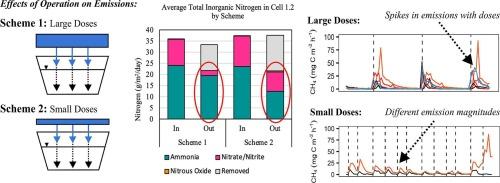亚高山带处理湿地的温室气体排放和氮去除:传质效应和剂量的含义
IF 4.1
2区 环境科学与生态学
Q1 ECOLOGY
引用次数: 0
摘要
今天,由于工业化和全球人口增长威胁到目前的排放趋势,人们越来越关注废水处理产生的温室气体排放(ghg)。本研究的重点是间歇加药对两级低温垂直流处理湿地(VFTW)处理3°C滑雪场废水的氧化亚氮(N2O)、甲烷(CH4)和二氧化碳(CO2)排放的影响。该系统具有部分饱和的第一级和不饱和的第二级,并进行循环以优化总氮的去除。经过两次自动化的闭环温室气体采样活动,在TW的16个地点,排放曲线因地点而异。较小的进水废水剂量导致溶解N2O的比例较高,并且由于反硝化不完全,整个系统的第一阶段都有碳限制的迹象。小剂量和大剂量导致CH4和N2O排放峰值,表明传质效应暂时增加了排放。CH4几乎全部在初级沉淀池中产生,从加药计划的第1至8小时观察到排放量下降了70%。此外,厚厚的积雪和冰透镜的形成导致了第一阶段的优先气体流动。这些结果表明,由于质量传递和阻碍运输的环境条件,TWs的温室气体排放估计值可能被错误地提高了。研究结果表明,由于废水系统的复杂性,需要持续清点温室气体,并且特定的废水应用方法可能有助于减少排放。本文章由计算机程序翻译,如有差异,请以英文原文为准。

Greenhouse gas emissions and nitrogen removal from a subalpine zone treatment wetland: Implications of mass transfer effects and dosing
Today, there is increased focus on greenhouse gas emissions (GHGs) from wastewater treatment, as industrialization and global population growth threaten to exponentiate current emission trends. This study focuses on the effects of intermittent dosing on nitrous oxide (N2O), methane (CH4) and carbon dioxide (CO2) emissions from a two-stage, low temperature vertical flow treatment wetland (VFTW) treating 3 °C ski resort wastewater. The system has a partially saturated first stage and unsaturated second stage with recycle to optimize for total nitrogen removal. Following two automated closed-loop GHG sampling campaigns across 16 locations in the TW, emission profiles were found to vary significantly by location. Smaller influent wastewater doses resulted in higher proportion of dissolved N2O and indications of carbon limitations across the first stage of the system due to incomplete denitrification. Small and large doses resulted in spikes of CH4 and N2O emissions, suggesting mass transfer effects temporarily increased emissions. CH4 was generated almost entirely in the primary sedimentation tank, with an observed 70 % drop in emissions from hours 1 to 8 of the dosing schedule. Additionally, heavy snowpack and ice lens formations resulted in preferential gas flow in the first stage. These results suggest that estimates of GHG emissions from TWs may be falsely elevated due to mass transfer and environmental conditions that hinder transport. The results indicate a need to continually inventory GHGs due to the complexity of wastewater systems, and that specific wastewater application methods may help to mitigate emissions.
求助全文
通过发布文献求助,成功后即可免费获取论文全文。
去求助
来源期刊

Ecological Engineering
环境科学-工程:环境
CiteScore
8.00
自引率
5.30%
发文量
293
审稿时长
57 days
期刊介绍:
Ecological engineering has been defined as the design of ecosystems for the mutual benefit of humans and nature. The journal is meant for ecologists who, because of their research interests or occupation, are involved in designing, monitoring, or restoring ecosystems, and can serve as a bridge between ecologists and engineers.
Specific topics covered in the journal include: habitat reconstruction; ecotechnology; synthetic ecology; bioengineering; restoration ecology; ecology conservation; ecosystem rehabilitation; stream and river restoration; reclamation ecology; non-renewable resource conservation. Descriptions of specific applications of ecological engineering are acceptable only when situated within context of adding novelty to current research and emphasizing ecosystem restoration. We do not accept purely descriptive reports on ecosystem structures (such as vegetation surveys), purely physical assessment of materials that can be used for ecological restoration, small-model studies carried out in the laboratory or greenhouse with artificial (waste)water or crop studies, or case studies on conventional wastewater treatment and eutrophication that do not offer an ecosystem restoration approach within the paper.
 求助内容:
求助内容: 应助结果提醒方式:
应助结果提醒方式:


